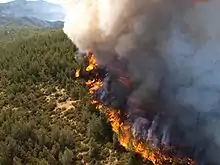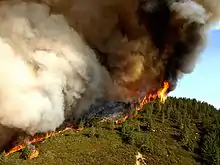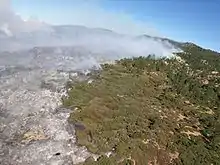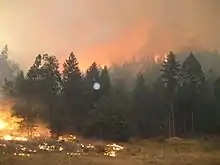Megafire
A megafire is an extraordinary fire that devastates a large area. They are characterized by their intensity, size, duration, and uncontrollable dimension. There is no precise scientific definition, and the concept may vary by region or country. In Europe, they are characterized as beginning at 1,000 hectares (2,470 acres), in size, while in the United States and elsewhere, they may be classified beginning at 10,000 hectares (24,710 acres). Another figure used in the United States is 100,000 acres (40,000 ha).[1]






A recent NASA study expands the megafire definition to include a variety of factors: "Between climate change and almost a century of fire exclusion, forest fires have become more extreme in size, severity, complexity of behavior and resistance to extinction. These fires are commonly referred as megafires and are at the extremes of historical variations.”[2] Almost all (96%) of the most disastrous 500 megafires in the past decade have occurred during periods of unusual heat and/or drought.[3]
Using one definition, only 3% of all fires reach "megafire" status, yet they are responsible for more than 50% of burned surfaces on the planet. The number of uncontrollable megafires is increasing.[4] They occur on all 6 continents that are permanently inhabited, including areas near the Arctic Circle.[5]
In recent years, some fires have burned over a million acres, becoming what has been dubbed as gigafires. These include the Yellowstone Fire in Montana and Idaho that burned 1.58 million acres in 1988; the Taylor Complex in Alaska that burned 1.3 million acres in 2004; the fires that burned 1.5 million acres in Victoria and New South Wales, Australia in 2020; and the August Complex in California in 2020.[6]
Operation of a megafire
These fires form pyrocumulus and pyro cumulonimbus, clouds which are also named "fire-breathing dragons". They cause giant thunderstorms, which often have little rain but with a strong potential for lightning, which can easily create and spread new fires. These huge fires are so intense that they generate their own climate.[5]
A mergers of fires can create a megafire, such as multiple fires during the 2019–20 Australian bushfire season in Australia, where multiple cases of many fires joining into a gigantic blaze were noted.[7]
Causes
A megafire can be caused by various factors, such as high temperatures, drought, human activites, and poor health of forests.[3][4]
Historic megafires
Megafires have affected multiple regions around the world, including Amazonia, California, Australia, Siberia,[5] Greenland,[8] Mediterranean Basin[9] and the Congo Basin.[10]
In the Mediterranean Basin, the countries affected by such fires include Spain, Portugal, Turkey, and Greece.[9]
In November 2018, the Camp Fire, a megafire in California, killed 85 people and ravaged 60,000 ha (150,000 acres).[11]
At the end of 2019, Brazil, Congo, Russia, and the United States had suffered from megafires on a scale described as "unprecedented".[3]
In Australia, during the 2019–20's bushfire season, numerous megafires erupted, with one consuming 1,500,000 acres (610,000 ha).[12]
The August Complex Fire in Northern California surpassed one million acres during the 2020 California wildfire season.
See also
References
- Kaur, Harmeet (2020-10-06). "California fire is now a 'gigafire,' a rare designation for a blaze that burns at least a million acres". CNN. Retrieved 2020-10-06.
- Joelle Zask (22 August 2019). Quand la forêt brûle: Penser la nouvelle catastrophe écologique (in French). Premier Parallèle. ISBN 9782850610059.
- "Les "mégafeux" sont-ils la nouvelle norme ?". United Nations Environment Programme. 10 January 2020. Retrieved 26 January 2020.
- "Les mégafeux vont devenir de plus en plus courants" (in French). Science & Life. 22 February 2019. Retrieved 26 January 2020.
- "Amazonie, Californie, Sibérie et Australie : que sont ces mégafeux qui dévastent les forêts du monde ?" (in French). France Inter. 8 January 2020. Retrieved 26 January 2020.
- Kaur, Harmeet (2020-10-06). "California fire is now a 'gigafire,' a rare designation for a blaze that burns at least a million acres". CNN. Retrieved 2020-10-06.
- "Australie : plusieurs incendies fusionnent en un "mégafeu" au nord de Sydney" (in French). franceinfo. 6 December 2019. Retrieved 26 January 2020.
- Lindgaard, Jade. "Les mégafeux, une catastrophe mondiale et totale". Mediapart (in French). Retrieved 2020-01-26.
- Science-et-vie.com (2019-02-22). "Les mégafeux vont devenir de plus en plus courants - Science & Vie". www.science-et-vie.com (in French). Retrieved 2020-01-26.
- Environment, U. N. (2020-01-10). "Les "mégafeux" sont-ils la nouvelle norme ?". UN Environment. Retrieved 2020-01-26.
- Andrew Hay (14 November 2018). "Deadly 'megafires' the new normal in California". Reuters. Retrieved 26 January 2020.
- "Enormous 'Megafire' In Australia Engulfs 1.5 Million Acres". NPR. 10 January 2020. Retrieved 10 January 2020.